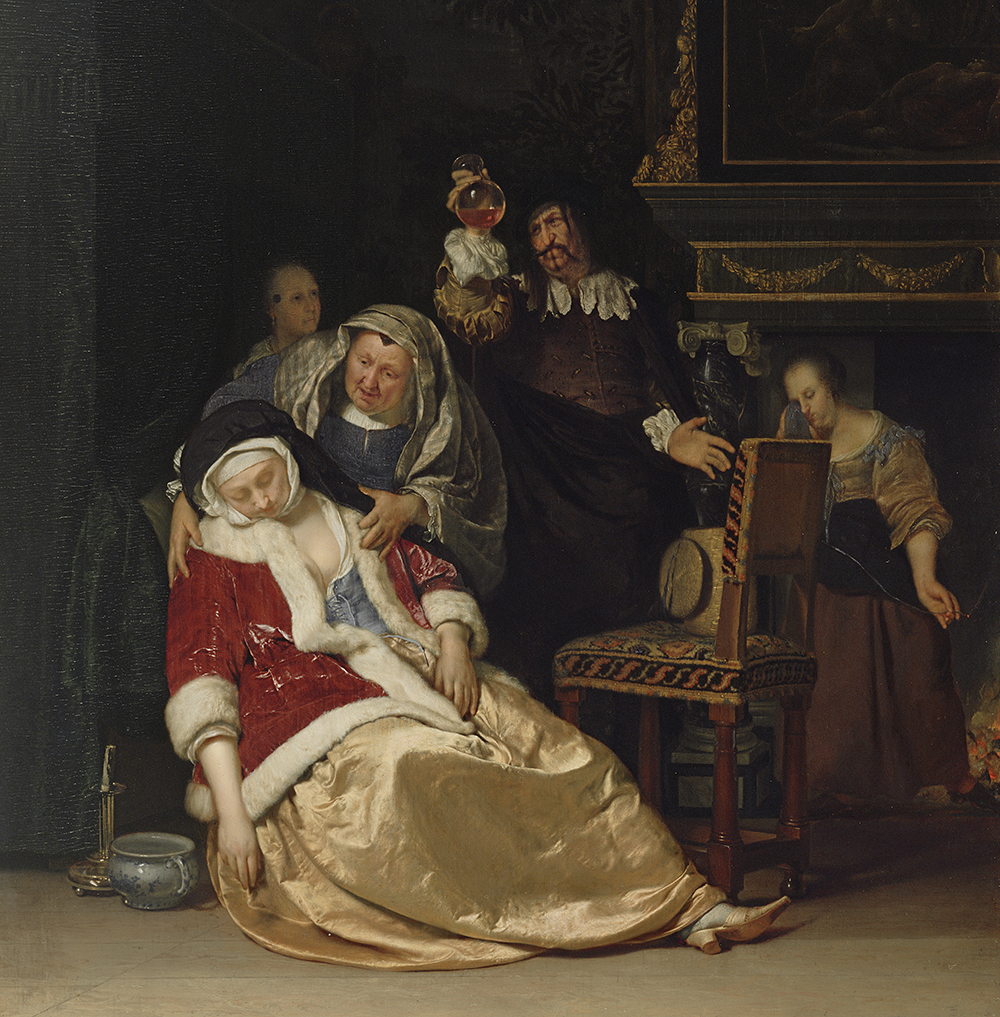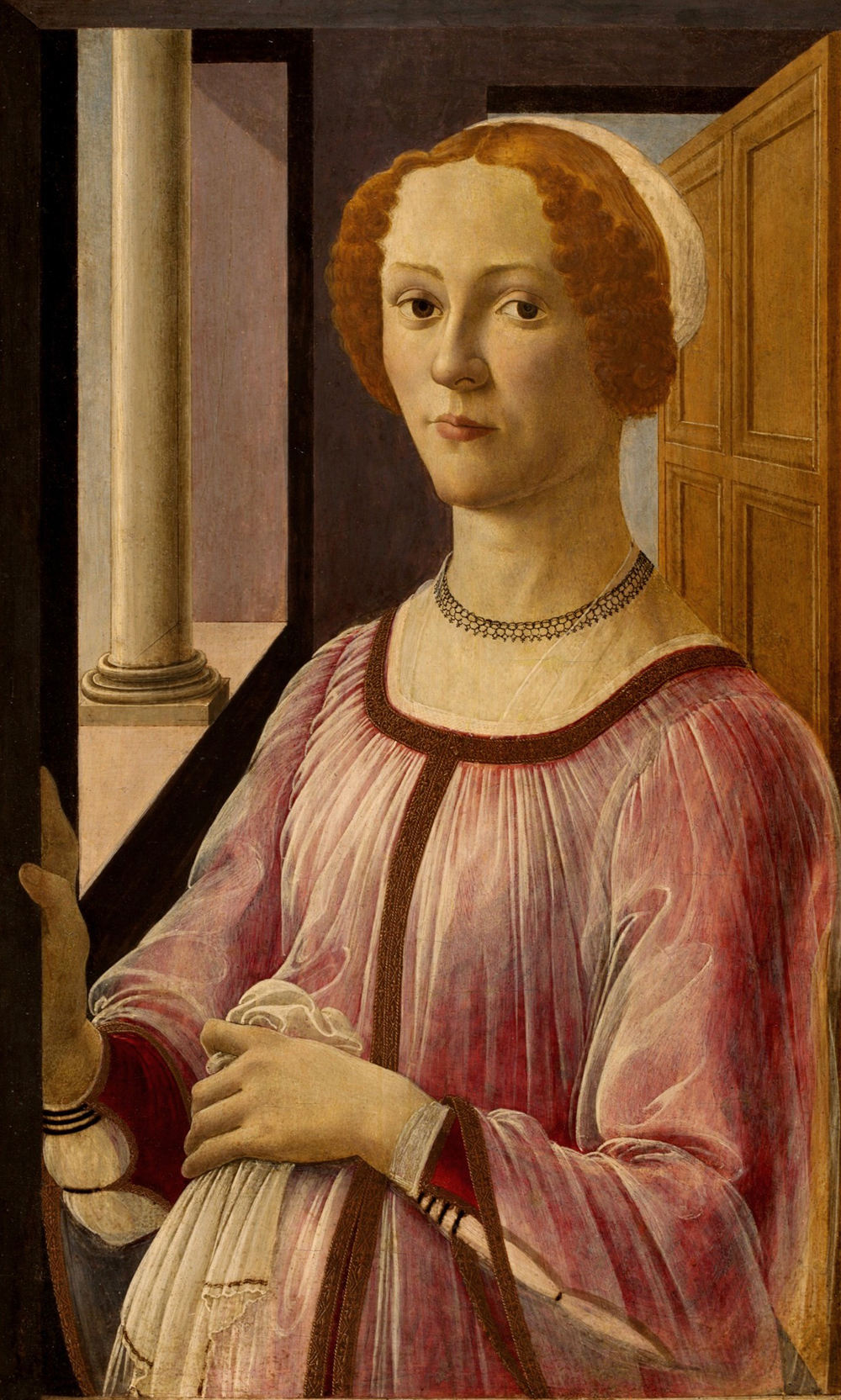
Woman Reading a Letter, by Johannes Vermeer, c. 1663. Rijksmuseum.
Italians lived in some of the most medically sophisticated cities and states in early modern Europe, and were remarkably health literate. Abortion was a feature of the medical landscape. Healers at all levels of the medical establishment provided women and men with materials and services to terminate pregnancies and with health care afterward. But in the sixteenth and seventeenth centuries, this was becoming more contentious. Some theologians and moralists labeled practitioners who participated in abortions sinners and murderers. Theologically minded medical authors increasingly pronounced on the sinfulness of procured abortion, depicted it as contrary to medical ethics, and urged healers to abstain from its practice for both their own souls and the spiritual and physical well-being of their patients. While health boards did not unequivocally prohibit the medical practice of abortion, they increasingly tried to regulate it by means of legislation. Only physicians were officially permitted to induce abortions and only for reasons of medical necessity. All other healers who participated in abortions by selling drugs or letting blood from pregnant women without a physician’s prescription were threatened with fines and corporal or capital punishment should a woman die as a result of their interventions.
Moral invocations and official restrictions did not, however, reduce demand. Healers knew how to work around the medical restrictions on abortion and when and how to resist or ignore them. Women and men in need learned to navigate this terrain: they knew how to find healers who would be sympathetic and helpful and those who would sell products without asking too many questions. They also knew how to present their bodies to make such transactions easier and less risky for the healer. Women and men could procure abortions by crafting illness narratives concealing their true intentions; medical practitioners might unwittingly participate, though they, too, could fall back on these narratives if they needed to exculpate themselves from participating in a prohibited practice. The ambiguities of the female body and uncertainties surrounding pregnancy complicated attempts to regulate abortion.
Corporal ambiguity—the understanding that bodily signs and symptoms could have multiple and even contradictory meanings—was a fact of early modern life. This was paradigmatically true for the female body, especially pertaining to generation and pregnancy. While anatomists developed more sophisticated understandings of the womb, that organ remained stubbornly opaque in living women. Children were born every day, but generation remained hidden and mysterious. Pregnancy could be both obvious and impossible to detect. One could never know with certainty what was taking place inside a woman’s belly, and attempts to discover its contents often ended in frustration, disappointment, surprise, danger, and sometimes death.
Pregnancy, especially early in term, was not a fixed or objectively known state but depended on the way a woman perceived and interpreted her bodily experiences, influenced by age and education, fears and desires, and the evaluations and input of familiars, onlookers, and sometimes medical practitioners. Pregnancy was only really confirmed with the delivery of a child, dead or alive. Prior to this, it was always uncertain—something people accepted. That uncertainty meant pregnancy was “to some degree negotiable.” While uncertainty was accepted, it was also cause for anxiety. It put women at risk of irrelevant, unnecessary, or dangerous medical interventions and exposed healers when they were called to diagnose and treat potentially worrisome symptoms. For individuals who wanted abortions and those who sought to provide them, uncertainty was a resource and a means to get around regulation.

Though it was accepted that the signs of pregnancy could be misleading, there was an intense desire to know as early as possible whether a woman had conceived. Male-authored medical treatises, letters women wrote to each other, and trial testimony from cases of abortion and miscarriage caused by assault allow some entry into perceptions and the phenomenology of women’s bodies, pregnancy, and its termination. Learned and popular works of women’s medicine and midwifery signaled the difficulty of identifying conception, as they enumerated its “common” signs, including a “tightening and contraction” in the womb, fatigue, headaches, vertigo, decreased libido, loss of appetite, unusual cravings, nausea, changes in the color and odor of urine, increased urination, constipation, paleness, sunken eyes, weight around the pubic bone and nave, and pain in the kidneys and lower back. While women, their familiars, and healers looked for these signs as potential indicators of pregnancy, it was accepted that these were relative—more pronounced in some, absent in others, and certainly not specific to pregnancy.
Surer indications that a woman was pregnant appeared over time. Absence of menstruation was one of the first signs women looked for to discover pregnancy. Women, especially newlyweds and elites, often monitored their menstrual cycles closely, as did their family members. According to medical theory of the time, pregnant women did not menstruate because the nutritive elements of menstrual blood were needed to nourish a growing fetus; later, blood was transformed into milk to feed the newborn. This transformation yielded another sign: a pregnant woman’s breasts swelled as they filled with milk that, further along, might come out when breasts were squeezed. If nursing a child, a woman was expected to stop lactating if she became pregnant. In 1634, in her lawsuit against her abusive husband for causing her to miscarry a three-months-developed fetus, Elena Cocchi explained that she knew she was pregnant at the time of the assault because “I did not have my times as I am used to having them and because the milk that was nursing my son dried up.” Coupled with nausea and a loss of appetite, these were “all similar signs that pregnant women have and that I had all the other times I was pregnant.”
If retained menstruation suggested pregnancy, a growing belly could make it public fact and a social experience. Early modern Italians scrutinized women’s bodies, and changes in shape and girth were topics of conversation and gossip. For newlywed women hoping to be pregnant, a growing belly might be displayed with pride and different clothing to alert observers to her soon-to-be status of matron. For single women lacking the prospect of marriage, a growing belly could be interpreted as the manifestation of sin and a wayward life; it could also alert onlookers to an episode of sexual violence. As such, it was threatening, something to be concealed, bound, and perhaps reversed by means of abortion. A growing fetus caused a growing belly and caught the eyes of neighbors, prompting gossip that shaped or reinforced a woman’s social identity.

For most medical practitioners and ordinary people, the most persuasive sign of pregnancy was the sensation of motion in a growing belly. The essayist Sperone Speroni reflected this: “I say, if the fetus moves, she is certainly pregnant.” Perceiving fetal motion, especially first movements, was often difficult. It was a subjective experience, influenced by numerous internal and external factors. Theologians and canonists equated motion with animation and theorized its date at forty days for a male fetus and eighty for a female. Medical authorities, unable to confirm or dispel these numbers (and likely thinking it was wise to leave the matter of animation to the theologians), related the timing of fetal motion to the fetus’s level of formation or development. Determining an exact time frame was admittedly impossible, so these authorities preferred to give a range. The famous physician, humanist, antiquarian, and Hippocrates apologist Girolamo Mercuriale thought a male fetus could be formed anywhere from thirty-five to fifty days after conception. Following a formula found in the works of Hippocrates, physicians thought the time required for the fetus to be strong enough to move was approximately double the time taken for its formation. Using Mercuriale’s numbers, this meant that if a male fetus was formed in forty days, it would begin to move around the eightieth day; if it was formed in forty-five days, it would begin to move around the ninetieth day. While suggesting precision, medical authors conceded there was no certainty in any of these numbers.
Waiting for the fetus to announce itself by moving could be a frustrating and anxiety-ridden disruption to everyday life. It indicates a uniquely gendered experience of time, where a woman’s days might be dominated by intense concentration on perceiving and evaluating physical sensations in the hope or fear that another being was growing in her body. The perception of motion depended on the size and vigor of the developing fetus but also on what the carrying woman paid attention to, what she felt, and how she interpreted it. Class, marital status, and circumstances influenced this. Newlywed women, especially elites hoping to be pregnant with a male heir, likely felt substantial pressure to identify fetal motion as early as possible; the earlier pregnancy was determined, the sooner a regime of care could be undertaken to maximize chances of a healthy pregnancy. Women not wanting to be pregnant but fearing they were likely also ruminated on every abdominal rumble: the sooner they suspected pregnancy, the sooner they might try to intervene to terminate it. Every bodily sensation would have been scrutinized. Yet even women whose bodies were closely monitored could miss or misinterpret signs. Young women generally learned about the signs and sensations of pregnancy from seasoned matrons. In the mid-seventeenth century, the young Roman noblewoman Eugenia Spada-Maidalchini reported to her mother, Maria Spada, that she only began looking for signs of pregnancy after her more experienced relatives instructed her to: “I think I felt the baby because of what they said,” Eugenia reported, “but I am not sure because I do not know if I can recognize it.” Recognizing “it” was not easy, requiring constant attention, education, experience, and often the oversight of experienced women.

While the cessation of menstruation, a growing belly, the sensation of motion, and eventual lactation were all regarded as the best indicators of pregnancy, they were far from determinative or universal, and this made abortion difficult to regulate. And all these signs invited several medical readings. The signs suggesting pregnancy were also symptoms of womb-related illnesses. Retained menstrual blood could be shaping and nourishing a growing fetus, but it could also be trapped. Menstrual retention (amenorrhea) was commonly seen to afflict women, especially virgins, nuns, and widows whose sexual inactivity, it was thought, made them more susceptible to womb-related illnesses. Menstrual retention also caused milk-like secretions from the breast (lactational amenorrhea). In the humoral system of medicine, a healthy and well-functioning body was one where humors flowed naturally throughout and were evacuated in a regular and balanced way. If humors became trapped due to a blockage (oppilatione), the body was unable to purify itself. Trapped humors could decay, making the body ill. Many illnesses afflicting women were understood to stem from a clogged womb unable to purify itself through menstruation, a natural and vital form of purgation by which the female body expelled abundant or corrupting humors on a regular basis.
Pregnancy’s shared signs with womb-related illnesses created conditions for shock, disappointment, and fear when women who hoped to be pregnant found they were instead suffering from a dangerous illness requiring therapy. The physician and Dominican friar Scipione Mercurio reported several instances of such missed diagnoses in his influential vernacular midwifery treatise. In one case, a woman of Tivoli believed herself pregnant as her belly grew, but after fifteen months of waiting, she passed a great amount of wind from her womb and her belly deflated, as did her hopes of birthing a child.
Conversely, women who thought themselves suffering from womb-related illnesses could discover they were actually pregnant. For some, this was joyous news; for others, devastating, creating a crisis in their lives. Mercurio recounts the case of an unnamed Venetian noblewoman who, after consulting several physicians regarding a mysterious illness, was diagnosed as “very sick” and in need of therapy. She traveled to Padua to be cured by the celebrated physician Ercole Sassonia of the University of Padua, who pronounced her not sick but pregnant. She gave birth a few months later to a “beautiful boy.” For Mercurio, this story served in part as evidence of pregnancy’s slipperiness but also as professional boasting—only the best physicians could “read” women’s bodies accurately.
But even the most learned and distinguished physicians made mistakes, and these could prove disastrous. In the late seventeenth century, Bernardino Cristini, a Franciscan friar and professor of medicine at Padua, described a situation he encountered while serving as the town doctor in Campitello (approximately ninety kilometers northeast of Trento). Virginia Roi, a twenty-eight-year-old widow, came to Cristini with a swollen belly thinking she was about six months pregnant. She said she felt all the sensations she had experienced in her previous three pregnancies. This was traumatic for Virginia because her husband was long dead and the “women of the town” were spreading rumors she had taken a lover, which Virginia vehemently denied. She even went to see her confessor to “certify that she was pregnant without knowing a man.” Eventually she consulted Cristini, who told her not to worry because her pregnancy was in fact dropsy, which could be healed. Eager to publicly prove her innocence and honesty, when Virginia began to feel the “pains of childbirth,” she called several women to her bedside to witness her expel a great quantity of water and wind, after which her belly subsided and her moral status was restored.
Discourses ascribing ambiguity and duplicity to the female body influenced the perceptions of onlookers and also shaped women’s relationships with their own bodies. In some circumstances, they experienced them as baffling and treacherous terrain, reflecting contemporary medical views and cultural expectations. Women learned to interpret their bodies through instruction and experience. For some women, absent periods, stomach pains, and a growing belly suggested pregnancy; for others, these same signs could be genuinely or willfully interpreted as indigestion, menstrual retention, dropsy of the womb, and other illnesses. Past experiences, self-awareness, and desire, as well as marital, familial, and social relationships, all shaped a woman’s interpretations of her body and factored into how observers chose to interpret and interact with it.
While ambiguity often put women in precarious situations, it was also a resource that women could manipulate to intervene in reproduction. Ecclesiastical, civic, and medical authorities worried that women might choose to perform their pregnant bodies as ill, crafting convincing narratives to trick healers into misdiagnosis in order to procure medicines to induce abortion. Bernardino Cristini cautioned, “There are women who are pregnant, from concubinage [or] adultery and they do not confess this, but rather try to fool physicians with the appearance of [menstrual] suppression, hoping to receive medicines and bloodletting [to induce] abortion. In these matters, physicians must be very warned.” This warning was difficult to heed. Medical practitioners acknowledged these situations put them at professional, legal, and perhaps moral risk, for which they had no solutions. However, these same ambiguities also provided healers with convenient defenses should a criminal investigation materialize in order to exculpate themselves from any wrongdoing.
Excerpted from Abortion in Early Modern Italy by John Christopoulos. Copyright © 2021 by the President and Fellows of Harvard College. Reprinted by permission of Harvard University Press.
